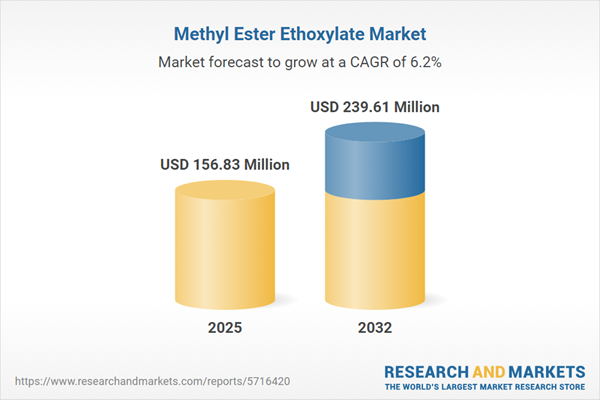Speak directly to the analyst to clarify any post sales queries you may have.
Methyl ester ethoxylate is emerging as a strategic asset for organizations prioritizing sustainability, operational flexibility, and rapid adaptation to evolving regulatory environments. As market demands shift toward greener chemistry and robust compliance frameworks, decision-makers are finding this next-generation surfactant integral to building future-ready supply chains and innovative product portfolios.
Market Snapshot: Methyl Ester Ethoxylate Market Trends and Growth
The methyl ester ethoxylate market continues its upward trajectory, achieving a valuation of USD 147.69 million in 2024 and targeting USD 156.83 million by 2025, supported by a projected CAGR of 6.23%. This progress closely aligns with increasing sustainability mandates and environmentally responsible procurement within major end-use sectors. Senior leaders are prioritizing resilient supply chains as regulatory expectations intensify globally. Methyl ester ethoxylate’s versatility fosters seamless integration across diverse industrial processes, enhanced by improvements in process chemistry and manufacturing reliability. These capabilities empower decision-makers to respond nimbly to shifting regulatory frameworks and stakeholder expectations.
Methyl Ester Ethoxylate: Scope & Segmentation
- Application Areas: Deployed in agrochemical dispersants, emulsifiers, wetting agents, dishwashing liquids, industrial detergents, surface cleaners, metal conditioning, textile processing, oil and gas drilling fluids, demulsification, and gentle personal care surfactant formulations.
- End-Use Industries: Adopted by agriculture, household care, industrial cleaning, oil and gas, textiles, and personal care sectors to achieve compliance targets and simplify procurement operations.
- Product Types: Encompasses bio-based variants for sustainable sourcing, specialty grades tailored for technical performance, and standard offerings to meet wide-ranging industry needs.
- Forms: Available in liquid, paste, and solid, providing compatibility with various manufacturing setups and optimizing process efficiency.
- Alkyl Chain Lengths: Options include C12–C14, C14–C16, and C16–C18 to enable customized solubility and performance characteristics for distinct processing requirements.
- Ethoxylation Degrees: Offered in low, medium, and high variants for precise performance across cleaning, emulsification, and operational uses.
- Geographic Regions: Present in North America, Latin America, Europe, Middle East, Africa, and Asia-Pacific, supporting local compliance and competitive engagement on a global scale.
- Key Market Players: BASF SE, Dow Inc, Evonik Industries AG, Stepan Company, Clariant AG, Croda International Plc, Solvay SA, Huntsman Corporation, and Kao Corporation, each advancing innovation and expanding product lines through focused research and development.
Methyl Ester Ethoxylate: Key Takeaways for Senior Decision-Makers
- Low aquatic toxicity accelerates adoption for applications with strict environmental compliance and simplifies certification for multi-regional operations.
- Rising interest in bio-based surfactants reflects a broader market transition toward more transparent, renewable sourcing and improved accountability.
- Demand for enhanced product transparency is making responsive sourcing strategies central to supply chain management and risk planning at scale.
- Collaboration across suppliers, manufacturers, and regulatory teams ensures smooth and rapid eco-labeling or certification, supporting faster adaptation to updated standards.
- Strategic investments in automation and analytics underpin operational resilience and stability, especially when navigating shifts in the regulatory or economic landscape.
- Broader adoption of research-driven customization allows businesses to differentiate offerings and strengthen their positions in evolving markets.
Tariff Impact: Addressing Cost Structure Challenges
Recent U.S. tariffs affecting surfactant feedstocks have prompted companies to revise sourcing strategies and invest in strengthening domestic production. Emphasis on vertical integration is safeguarding essential raw materials and reinforcing supply continuity. This approach mitigates exposure to external disruptions and sustains reliable operations as the global trade environment evolves.
Methodology & Data Sources
This analysis draws from direct interviews with procurement and R&D leaders, validated by leading industry publications and compliance resources. An external panel of sector experts reviews all findings to ensure relevance and reliability for executive use.
Why This Report Matters
- Presents actionable intelligence that empowers leadership to identify growth trends, anticipate regulatory changes, and streamline compliance across multiple sectors.
- Delivers independently verified analysis of competitive moves, technology updates, and market shifts to support measurable organizational results.
- Enables benchmarking with industry peers, spotlighting strategic movements and innovation drivers shaping the methyl ester ethoxylate landscape.
Conclusion
Methyl ester ethoxylate supports sustainable growth, operational flexibility, and resilient supply networks. Equipped with these targeted insights, senior decision-makers are positioned to refine strategies and enhance market agility through evolving industry cycles.
Additional Product Information:
- Purchase of this report includes 1 year online access with quarterly updates.
- This report can be updated on request. Please contact our Customer Experience team using the Ask a Question widget on our website.
Table of Contents
3. Executive Summary
4. Market Overview
7. Cumulative Impact of Artificial Intelligence 2025
Companies Mentioned
The companies profiled in this Methyl Ester Ethoxylate market report include:- BASF SE
- Dow Inc
- Evonik Industries AG
- Stepan Company
- Clariant AG
- Croda International PLC
- Solvay SA
- Huntsman Corporation
- Kao Corporation
Table Information
| Report Attribute | Details |
|---|---|
| No. of Pages | 186 |
| Published | November 2025 |
| Forecast Period | 2025 - 2032 |
| Estimated Market Value ( USD | $ 156.83 Million |
| Forecasted Market Value ( USD | $ 239.61 Million |
| Compound Annual Growth Rate | 6.2% |
| Regions Covered | Global |
| No. of Companies Mentioned | 10 |









